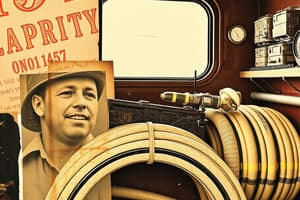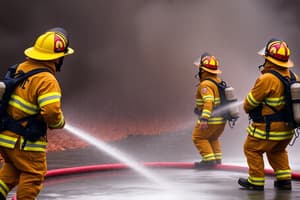Podcast
Questions and Answers
What is the first step in the procedure for removing a nozzle?
What is the first step in the procedure for removing a nozzle?
- Pick up the nozzle with both hands. (correct)
- Break the seal of the gasket.
- Dress the hose flat and straight.
- Grasp the hose coupling with the left hand.
During the one member fold, what position should the nozzle be in after it has been attached?
During the one member fold, what position should the nozzle be in after it has been attached?
- Above the head.
- Over the back of the right shoulder. (correct)
- Parallel to the left leg.
- Held in front of the body.
What should be done with the right hand when breaking the nozzle over the left hand?
What should be done with the right hand when breaking the nozzle over the left hand?
- Leave it unsupported.
- Hold the nozzle horizontally.
- Push against the coupling.
- Point it towards the ground. (correct)
In the process of attaching a nozzle, where is the visual gasket check performed?
In the process of attaching a nozzle, where is the visual gasket check performed?
What is the correct order of hand placement when breaking the nozzle seal?
What is the correct order of hand placement when breaking the nozzle seal?
What should be retained while performing the one member fold?
What should be retained while performing the one member fold?
What action is taken first when using a hose coupling?
What action is taken first when using a hose coupling?
Which of the following describes an important safety practice with hoses?
Which of the following describes an important safety practice with hoses?
What is the first action the nozzle member takes after disconnecting the 4" hose from the 4-way valve?
What is the first action the nozzle member takes after disconnecting the 4" hose from the 4-way valve?
When should the 200 Series engine proceed to the hydrant after the nozzle member has made connections?
When should the 200 Series engine proceed to the hydrant after the nozzle member has made connections?
What action should the hydrant member perform after two couplings have come out or the 200 Series engine stops?
What action should the hydrant member perform after two couplings have come out or the 200 Series engine stops?
What is the purpose of the nozzle member checking for kinks in the line?
What is the purpose of the nozzle member checking for kinks in the line?
Which component is used by the engine engineer for the suction inlet?
Which component is used by the engine engineer for the suction inlet?
What is the appropriate hose lay order given by the officer?
What is the appropriate hose lay order given by the officer?
What should the hydrant member do immediately after returning to the jumpseat on the engine?
What should the hydrant member do immediately after returning to the jumpseat on the engine?
What is a critical safety practice when handling hoses?
What is a critical safety practice when handling hoses?
What is the first action that the nozzle member takes after the engineer calls for 'water'?
What is the first action that the nozzle member takes after the engineer calls for 'water'?
When can the nozzle member advance the 1-1/2" or 1-3/4" line if the ladder is positioned to the left rear of the apparatus?
When can the nozzle member advance the 1-1/2" or 1-3/4" line if the ladder is positioned to the left rear of the apparatus?
What is the correct placement of couplings when advancing them to the ladder?
What is the correct placement of couplings when advancing them to the ladder?
How far behind the nozzle member should the hydrant member shoulder the hose line?
How far behind the nozzle member should the hydrant member shoulder the hose line?
What action does the nozzle member take before ascending the ladder?
What action does the nozzle member take before ascending the ladder?
What indicates that the hydrant member should ascend the ladder?
What indicates that the hydrant member should ascend the ladder?
What is the responsibility of the aboveground members in the hose handling process?
What is the responsibility of the aboveground members in the hose handling process?
What does the nozzle member signal when the proper amount of hose has been pulled up to the fire floor?
What does the nozzle member signal when the proper amount of hose has been pulled up to the fire floor?
Flashcards are hidden until you start studying
Study Notes
Attaching a Nozzle
- Position left leg to form a work table above the knee, grasp hose coupling with the left hand.
- Perform a visual gasket check before attaching nozzle to hose coupling.
- Hold hose with left hand behind coupling while breaking the nozzle over the left hand (tip pointing downward).
- Use right hand to shut off the nozzle after breaking it.
- Pivot hose 180 degrees counterclockwise, relocating nozzle over the back of the right shoulder.
Removing a Nozzle
- Utilize both hands to pick up the nozzle, right hand should grip the nozzle tip.
- Left hand forms a work table on the left leg, holding hose coupling.
- Regain grip of nozzle with right hand at the shut-off butt or double male.
- Break the seal of the gasket before removing the nozzle from hose coupling.
One Member Fold
- Flake out a section of hose, ensuring it is flat and straight.
- Break coupling while retaining male coupling in the left hand and bed female coupling with right hand.
- Attach the correct nozzle (not a double male) to the male coupling, ensuring it is shut off.
- Place the nozzle over the back of the right shoulder while facing the flaked hose.
- Disconnect 4" hose from 4-way valve, leaving increaser attached.
Hose Operations
- Nozzle member shoulders 4" coupling and pulls hose to officer's location.
- Connect 4" line from engine to 4" double male previously attached to the line from the 200 Series engine.
- Check for kinks in the hose line after making final connections.
- Hydrant member instructs engine to "take off" for relocation to the hydrant once the area is clear.
Supply Line Management
- Assert "take off" command when the hydrant member returns to their jumpseat; engine proceeds to the fire.
- Officer designates the hose lay type.
- Hydrant member pulls a running line from engine and dresses it for deployment.
- Engineer acquires proper fittings for suction inlet (4" double female) and relieves the hydrant member.
- Shoulder male coupling on the inside shoulder for connection at the suction inlet while the engineer calls for "water."
Advancing Hose Lines
- Nozzle member removes firefighting line from the apparatus.
- Advance 1-1/2" or 1-3/4" line to the closest ladder beam, coordinating with other members.
- Couple up hoses according to ladder positioning, placing couplings aligned straight from the center of the ladder rungs.
- Hydrant member assists nozzle member in advancing the appropriate number of couplings post-hydrant retrieval.
Ladder Operations
- Nozzle member regains and shoulders the nozzle in preparation for ladder ascent.
- Hydrant member shouldered 25 feet behind the nozzle member, readying to advance.
- Ascend the ladder after ensuring hose line is appropriately managed.
- Hydrant member follows the nozzle member when the hose loop reaches knee height.
- Aboveground team hoists and flakes hose line as it is pulled into their location.
- Signal for "water" once adequate hose length is pulled up to the fire floor.
Studying That Suits You
Use AI to generate personalized quizzes and flashcards to suit your learning preferences.



